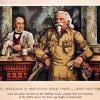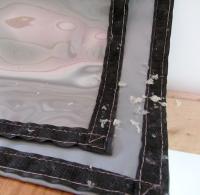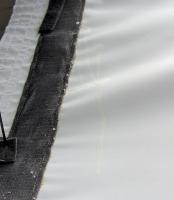Ok, thanks so much Bill, I will look into it!

2001 FWC Hawk how to remove uncured seam seal & repair leaking rear door window
#21

Posted 28 June 2016 - 05:43 AM
#22

Posted 04 July 2016 - 12:15 AM
erika--
I picked up a can of 3M Adhesive Remover 03618 at my local Advance Auto (here it is on Amazon) and have been working with it a bit the last few days as time permits.
I had minor glue marks on my headliner and a simple wipe with a remover-soaked paper towel took it off. The sewn-through seams also cleaned up easily but I had the same experience you had--- a stickiness returned in a little while.
I wondered whether that stickiness might actually be very diluted adhesive so changed to only making a pass or two with the paper towel while the solvent was still very wet before throwing the towel away (rather than continuing to rub). That seemed to help. At this point I'd say I'm about 90 per cent done inside.
I was less successful on the outside. The problem, as described in a previous post, is the glue in the velcro hook material. I did make some progress using a small parts-cleaning brush and liberally spraying it (the brush) with solvent. But in the end I still have tacky velcro. The glue doesn't come off on your fingers anymore but, as I say, it's still a bit tacky to the touch. The solvent did clean up the ultra-sticky glue under the edges of the velcro. And I soon learned that if the glue was shiny and sticky, I could get it off with the solvent (so long as it wasn't trapped in the velcro hooks or loops). However, it didn't do anything for my worst glue-stain. That one isn't shiny or sticky, it's just a very light brown former glue splotch on the vinyl, hopelessly ingrained in the material and apparently too dried out to interact with the solvent.
The 3M product is easy enough to work with as far as application but has a wickedly-strong chemical odor and of course it's an aerosol so puts a fine mist in the air. That builds up quickly in a closed environment. Because of the strong odor, I could only work inside for a few minutes then had to switch to the exterior to continue working. And I limited work to about a half-hour at a time.
The manufacturer says the solvent is safe for vinyl and I saw no reason to disagree. The underlying vinyl seems unaffected. I will, however, be doing a cleaning and application of 303 protectant (it's due anyway).
'01 FWC Hawk shell on a '13 Tundra Double-Cab + '19 Ford Transit van with Quigley 4x4 option
#23

Posted 04 July 2016 - 07:10 AM
You can find cans of liquid 3M Adhesive Remover at places like West Marine. An alternative to the spray. I use it all the time for boat work. Works well, it can even remove the silicone remnants from old hatches on resealing jobs. I use it on fiberglass and plastic parts no problem.
2016 F-150 FX4 XLT SCab | Ingot Silver | 6.5' | 3.5EB | 3.55 w/rear locker | Tow | IBC | 7050# GVWR | 1945# Payload | 36Gal | BFG A/T KO2 LT275/70R18E | Timbrens
2022 FWC Hawk Silver Spur | Front Dinette | Cassette Toilet | Cooktop | Hot Water | Outside shower | CR850 fridge | 160W rooftop solar panel | 15A MPPT controller | Dual 90AH AGM batteries | Yakima Rack | 2 Maxxair fans | Furnace | Fiama side awning | Mechanical Jacks
#24

Posted 05 July 2016 - 12:50 PM
You can find cans of liquid 3M Adhesive Remover at places like West Marine. An alternative to the spray. I use it all the time for boat work. Works well, it can even remove the silicone remnants from old hatches on resealing jobs. I use it on fiberglass and plastic parts no problem.
Thanks for the tip! I wish I had known of this product when I re-did the window in my Hawk's door. I spent a lot of time digging out the silicone as best I could but it left a greasy-looking residue on the plastic. I believe this would have cleaned that up and better prepared the surface for the new silicone.
'01 FWC Hawk shell on a '13 Tundra Double-Cab + '19 Ford Transit van with Quigley 4x4 option
#25

Posted 05 July 2016 - 11:19 PM
Old Crow -
Cool you worked on yours and had some luck removing it! Good to know about all the 3M cleaners, although I know I could not use them being chemical sensitive. I would say the natural citrus cleaner (CitraSolv) that I used did remove 95% on the inside as well, maybe a full 100%. The issue was during the drying process that would wick in more glue. I don't think it's possible to completely remove all the glue residue since it just keeps melting/oozing from the back of the velcro, and then wicks through the stitching on a hot day. It's way better though so we can deal with it.
We had the same issues you did with the exterior. The day we bought it, I wiped a clear glue drip with a towel near the exterior velcro and it left a permanent mark that has not come off with any of the cleaners. It's not a big deal but surprised me that this 'new' mark would not come off. Great explanation about what came off and what didn't. We were able to remove a lot of the shiny goo but all the black stains were permanent. At least I know it's as clean as it gets at this point.
Thanks for all the great help!
#26

Posted 06 September 2016 - 04:57 PM
Update:
After erika posted the info on Citra-Solv Concentrate, I went looking for it locally. The Citra-Solv web site has a store-finder which identified two local grocery store chains as carrying their products but that turned out to be true only for their larger stores. Also, the trick is to check the organic and natural products aisles, not the cleaning products aisles. And as erika notes-- you want the concentrate, not the spray as it's too diluted to be effective.
I found the Citra-Solv worked well though I did have to be extra-careful with the tippy little bottle. I found it more convenient to transfer it to an old spray bottle so I wouldn't accidently spill and so I could spray on instead of wipe on.
The Citra-Solv works a bit differently than the 3M Adhesive Remover. The former produces some glue 'fur-balls' (see below) while the latter just seems to keep dissolving a bit of the glue on each cleaning pass.
Having tried both products, I think the 3M one edges out the Citra-Solv in effectiveness and ease of application but the smell of the 3M one is very strong and, in fact, dizzying in a confined space. Neither product damages the vinyl but the 3M product will take the paint off the aluminum siding.
Both products were effective on the interior stitching and on clear, sticky glue spots like this on the exterior:
Neither product was effective on old dried-up stains like this on the exterior:
A few months have passed since I first did the cleanup. We've had a very hot summer here and I'm not surprised to find I need to do another round. The interior stitching merely has a bit of a tacky feel and I'm not seeing staining on the ceiling or bed. On the outside I have a few small clear-and-sticky spots I know will come off fairly easily. All I can do is keep at it and hope to run out of glue!
-Old Crow
PS- I also considered trying to block the flow of glue by gluing down the edges of the exterior velcro with a higher-temp glue (VLP). I only tried it on a short stretch but it didn't go well so I bailed.
'01 FWC Hawk shell on a '13 Tundra Double-Cab + '19 Ford Transit van with Quigley 4x4 option
#27

Posted 27 September 2017 - 08:38 PM
I know it's over a year since this discussion opened. Just wanted to weigh in. I bought a 2002 Eagle that had been stored outside for several years untouched in sunny CA. It had the same problem with sticky, nasty stuff everywhere on cushions, walls, top of cabinet, etc. Like you all, I tried everything and finally got most of it off. De-Solv-It worked best for me but left that awful small for a year or so! I tossed the bed cushions and treated/washed the couch cushions twice - just one spot yet. There's still an occasional sticky spot after 3.5 years but I can live with that.
What I need advice on is the best product to re-seal the side seams that I had to work hard to lean. I can see a little daylight through the stitching and it brings in more moisture than it should when it rains. Thinking of trying basic tent seam sealer, but thought I'd ask if anyone else has experience first.
Thanks!
#28

Posted 27 September 2017 - 09:27 PM
Hello Brookie,
Yah, I couldn't tolerate the toxic chemical smell of De-Solv it. Citrasolv worked best for me and is totally non-toxic and doesn't leave a nasty odor. Most health food stores carry it.
Our bed cushions were stained with mold and the upholstery had an awful odor so I pulled both of them out and bought a pvc-free Lightspeed air mattress for $60. It works great, except it is a little high and leaves less space to move. I also discovered air mattresses are not insulating and it therefore requires a warm blanket on top of the mattress.
We, too, have had problems with the seams wicking in water when it rains. I would like to seam seal them if I could ever get ALL of the sticky residue off. It's mostly gone from the inside but it does wick in glue from the outside seams when it's hot out. I'm also not sure what you use for this purpose. Most products contain urethane and are very toxic.
Also tagged with one or more of these keywords: seam seal, leaking window seal, 2001 Hawk FWC, mold
Trucks, Campers, Gear Forums →
Truck Campers →
Four Wheel Camper Discussions →
Propane Box CondensationStarted by Roaming_Eagle , 22 Feb 2018 |
|

|
0 user(s) are reading this topic
0 members, 0 guests, 0 anonymous users


















